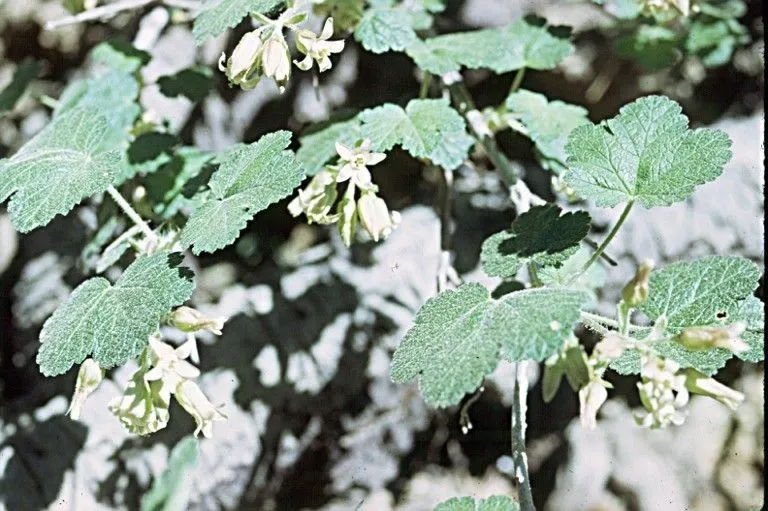
Author: Pursh
Bibliography: Fl. Amer. Sept. 1: 163 (1813)
Year: 1813
Status: accepted
Rank: species
Genus: Ribes
Vegetable: False
Observations: W. Canada to W. & WC. U.S.A.
Sticky currant, scientifically known as Ribes viscosissimum, is a fascinating species of flowering plant that belongs to the Grossulariaceae family. Described by the botanist Frederick Traugott Pursh in the influential botanical reference “Flora Americae Septentrionalis” published in 1813, this plant has garnered interest for its unique characteristics and natural habitat.
Native to the northern regions of North America, Sticky currant is predominantly found in the western and west-central parts of the United States as well as parts of western Canada. This geographical distribution includes a range of climates and elevations, where the plant thrives in diverse ecosystems.
Sticky currant is aptly named for the sticky, glandular hairs that cover its stems and leaves, giving the plant a distinctive texture and appearance. This deciduous shrub typically grows to a moderate height and features lobed leaves that are alternate and simple. During its blooming period, Sticky currant produces clusters of small, attractive flowers that vary in color from white to a delicate pink. These flowers are known to attract various pollinators, which are crucial for the plant’s reproduction.
Following the flowering season, Sticky currant develops small, berry-like fruits that are edible, though they are not widely known for their culinary use. The berries can be an important food source for wildlife, contributing to the ecological diversity of the regions where the plant is found.
In addition to its ecological value, Sticky currant has potential uses in ornamental gardening due to its unique appearance and adaptability to different environments. Its resilience in various soil types and weather conditions makes it an appealing choice for gardeners looking to cultivate native species that support local biodiversity.
Overall, Ribes viscosissimum represents a notable element of the flora in its native regions, offering both aesthetic and ecological benefits. Its presence across a broad swathe of North America underscores its adaptability and the importance of preserving the natural habitats where it thrives.
Eng: sticky currant, mountain currant, sticky gooseberry
Fra: gadellier visqueux
En: Sticky currant, Mountain currant, Sticky gooseberry
Fr: Gadellier visqueux
Taken Oct 14, 2010 by EOL − Barry Breckling (cc-by-nc-sa)
Taken Feb 6, 2010 by EOL − Keir Morse (cc-by-nc-sa)
Taken Feb 6, 2010 by EOL − Keir Morse (cc-by-nc-sa)
Taken Mar 12, 2009 by EOL − Keir Morse (cc-by-nc-sa)
Taken Mar 12, 2009 by EOL − Keir Morse (cc-by-nc-sa)
Taken Nov 7, 2015 by EOL − Barry Breckling (cc-by-nc-sa)
Taken Feb 6, 2010 by EOL − Keir Morse (cc-by-nc-sa)
Taken Mar 12, 2009 by EOL − Keir Morse (cc-by-nc-sa)
Taken Aug 18, 2011 by EOL − Steve Matson (cc-by-nc)
Taken Sep 8, 2001 by EOL − Dean Wm. Taylor (cc-by-nc-sa)
Taken Feb 6, 2010 by EOL − Keir Morse (cc-by-nc-sa)
Taken Feb 6, 2010 by EOL − Keir Morse (cc-by-nc-sa)
Taken Feb 6, 2010 by EOL − Keir Morse (cc-by-nc-sa)
Taken Feb 6, 2010 by EOL − Keir Morse (cc-by-nc-sa)
Growth habit>: Shrub
Growth rate>: Moderate
Ph maximum: 8.4
Ph minimum: 5.8
Family: Myrtaceae Author: (F.Muell.) K.D.Hill & L.A.S.Johnson Bibliography: Telopea 6: 402 (1995) Year: 1995 Status:…
Family: Rubiaceae Author: Pierre ex A.Froehner Bibliography: Notizbl. Bot. Gart. Berlin-Dahlem 1: 237 (1897) Year:…
Family: Sapindaceae Author: Koidz. Bibliography: J. Coll. Sci. Imp. Univ. Tokyo 32(1): 38 (1911) Year:…
Family: Asteraceae Author: A.Gray Bibliography: Pacif. Railr. Rep.: 107 (1857) Year: 1857 Status: accepted Rank:…
Family: Fabaceae Author: Medik. Bibliography: Vorles. Churpfälz. Phys.-Ökon. Ges. 2: 398 (1787) Year: 1787 Status:…
Family: Aspleniaceae Author: (Cav.) Alston Bibliography: Bull. Misc. Inform. Kew 1932: 309 (1932) Year: 1932…